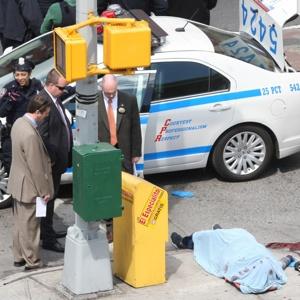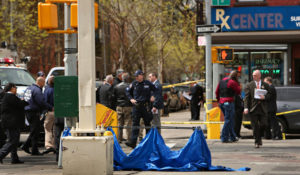Back in April of last year, a retired NYPD Lieutenant shot and killed an armed robber who was attempting to shoot the three police officers who were trying to apprehend him.
The shooting is unusual for two reasons: One is that the shooter is a RETIRED cop. He essentially is in the same position and has the same responsibilities as any other citizen who is legally carrying a firearm. The second is that the shooting was videotaped by another police unit’s surveillance team.
Read the article and see the video here:
Retired NYPD Lt. guns down armed robber
The shootout occurred after three police officers responded to a robbery holdup alarm that was triggered when two men were robbing the pharmacy at gunpoint. The officers arrived before the robbers left the store.
As the first robber was walking out, the officers confronted him and ordered him to the ground just outside the store. They didn’t see the second robber, who sprinted out past them, attempting to fire his revolver as he ran.
The retired officer, who was filling up his car with gas across the street, intervened. He shot at the robber three times, hitting him twice in the head from a distance of 55 feet.
Lessons learned
1) If you are a cop responding to a violent felony in progress, don’t rush in. Don’t create a hostage situation in the store. Get to cover, wait for the criminals to exit and take them down on the street or sidewalk. Having cover in this situation not only protects you from bullets, it buys time to make a better decision.
2) If you are walking down the street and see three cops approach with their guns in hand, it might be a clue that you are caught up in a dangerous situation. GET OUT OF THERE! I can’t tell you how many times I have seen people stop to watch as I arrest a criminal at gunpoint.
Watch the people on the sidewalk in the video. Some move quickly, but some just stand and watch in the middle of a gunfight. It’s stupid and dangerous behavior. Don’t be like the people you see here. Seek cover or get out.
3) Recognize criminals often work in pairs or teams. It is estimated that 40% of robbers have at least one accomplice. Always be looking for the primary suspect’s friends. He may even have a lookout or getaway driver in this situation that the cops never saw.
4) Realize that criminals often carry crap guns. This guy had a .32 revolver. He attempted to fire three times and none of the bullets went off. In my research collecting guns seized from criminals at my police department, I find that about 50% of them are broken, unloaded, or loaded with the wrong ammunition.
Don’t give up the fight just because a criminal has a gun. There’s a good chance it won’t work.
5) These events happen fast. The retired officer didn’t have time to analyze all of his possible options. He just had time to act. Pre-plan your responses to violent scenarios BEFORE they happen, because you won’t have much time to think in a crisis situation. Would you have intervened in a similar situation?
6) Notice the retired officer’s rapid lateral move to cover, smooth draw, and accurate shooting. That doesn’t happen by chance. That happens as a result of practice. If you aren’t practicing moving, shooting from behind cover in odd positions, and long range rapid fire shooting techniques, you aren’t really preparing for a gunfight. Practice as often as possible and make your training as realistic as your range and safety allows.
7) Watch the end of the video. Note what the retired cop did…he kept both hands in view, walked slowly out from his cover into an open area and held his identification (or badge) high in his hand so that cops knew he wasn’t a threat. Smart moves on his part.
If you shoot someone, you will have to deal with the police. Be ready for them. Don’t make fast or threatening moves. Obey their commands and keep your gun out of sight. You will likely be ordered to the ground, searched and handcuffed. Expect it and be ready for it to happen.
The serious student of the art uses videos and stories like these to play the “What If?” game. Mentally put yourself in a similar situation and think through your response options. Come up with a plan that works FOR YOU. Then train that plan intensely until the actions become second nature.




